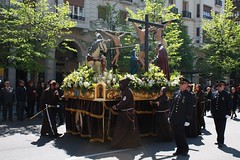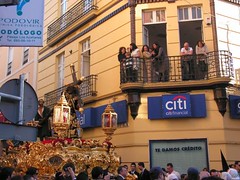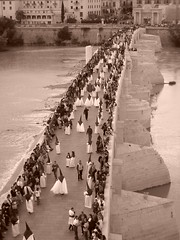 by JuanedcSemana Santa. Holy week. When I think of the places I want to spend Holy Week in, I would automatically think that Italy would be the best place to do so. However, having spent a disappointing Ash Wednesday at St. Peter’s Basilica in the Vatican City, I decided to give Spain a fair chance. After all, I do live here now, right?
by JuanedcSemana Santa. Holy week. When I think of the places I want to spend Holy Week in, I would automatically think that Italy would be the best place to do so. However, having spent a disappointing Ash Wednesday at St. Peter’s Basilica in the Vatican City, I decided to give Spain a fair chance. After all, I do live here now, right?
 Semana Santa, as it’s called here, blew the Pope’s socks off – and I generally like the Pope’s socks. I headed to Vejer de la Fronterra for one of the nights of Semana Santa where they were actively participating in the procession. You see, each village in Spain with a main cathedral has processions. During the month and a half of Lent, each church puts together a giant statue, or paso of one of the stations of the cross, or of a saint or something else significant to the particular church. These pasos are put on giant pedistals for the Lenten season on display inside the church.
Semana Santa, as it’s called here, blew the Pope’s socks off – and I generally like the Pope’s socks. I headed to Vejer de la Fronterra for one of the nights of Semana Santa where they were actively participating in the procession. You see, each village in Spain with a main cathedral has processions. During the month and a half of Lent, each church puts together a giant statue, or paso of one of the stations of the cross, or of a saint or something else significant to the particular church. These pasos are put on giant pedistals for the Lenten season on display inside the church.
 by Fernand0During Semana Santa, each of the pasos are laden with fresh flowers. Women come in and spend days decorating them with roses, carnations, wildflowers. They each end up looking a bit like a float off the rose parade. Then one at a time, each church marches their paso up to the main cathedral in town. Traditionally, the pasos are carried by men who have penance that needs to be served, called costaleros. They are covered by a drape that drags to the ground on all four sides of the paso and the men must carry it on their shoulders in bare feet usually for a couple miles. Sometimes, the men even wear shackles if they've been particularly bad.
by Fernand0During Semana Santa, each of the pasos are laden with fresh flowers. Women come in and spend days decorating them with roses, carnations, wildflowers. They each end up looking a bit like a float off the rose parade. Then one at a time, each church marches their paso up to the main cathedral in town. Traditionally, the pasos are carried by men who have penance that needs to be served, called costaleros. They are covered by a drape that drags to the ground on all four sides of the paso and the men must carry it on their shoulders in bare feet usually for a couple miles. Sometimes, the men even wear shackles if they've been particularly bad.
 by JuanedcThose men who did not behave as badly during lent (or whatever you had to do to deserve 6 hours of holding a 3 ton statue on your shoulders) wear large robes called capirote which are the robes that inspired the traditional garb of the KKK. You know, the ones with the pointy hats. Each of the robes is a different color depending on what church you come from and the men march alongside the statues with large grim reaper type canes and torches of fire. If you had told me we had been transported back in time to some sort of Neo Nazi ritual, I honestly wouldn’t have been too surprised. In addition, each church has its own marching band that walks in front or behind the statue beating out the slow rhythm to which the statue sways down the city streets.
by JuanedcThose men who did not behave as badly during lent (or whatever you had to do to deserve 6 hours of holding a 3 ton statue on your shoulders) wear large robes called capirote which are the robes that inspired the traditional garb of the KKK. You know, the ones with the pointy hats. Each of the robes is a different color depending on what church you come from and the men march alongside the statues with large grim reaper type canes and torches of fire. If you had told me we had been transported back in time to some sort of Neo Nazi ritual, I honestly wouldn’t have been too surprised. In addition, each church has its own marching band that walks in front or behind the statue beating out the slow rhythm to which the statue sways down the city streets.
 by ~ZitaNow, if these streets were wide, I’m not sure there would be too much fuss. Walk a statue, for example, from St. Monica’s in Los Angeles up Wilshire and you’re not going to have too much trouble navigating. Traffic would likely not even stop. However, the statues themselves, being at least 8 feet wide, on cobble city streets that are barely 12 feet wide and navigating hairpin corners ON A 12% INCLINE, is not an easy feat. Add three rows of people on either side of the sidewalk whose feet you’re trying to not step on and I’m not sure what kind of forgiveness would be enough to volunteer me for that job.
by ~ZitaNow, if these streets were wide, I’m not sure there would be too much fuss. Walk a statue, for example, from St. Monica’s in Los Angeles up Wilshire and you’re not going to have too much trouble navigating. Traffic would likely not even stop. However, the statues themselves, being at least 8 feet wide, on cobble city streets that are barely 12 feet wide and navigating hairpin corners ON A 12% INCLINE, is not an easy feat. Add three rows of people on either side of the sidewalk whose feet you’re trying to not step on and I’m not sure what kind of forgiveness would be enough to volunteer me for that job.
 by CrucconeOn the final day of Semana Santa, all of the pasos are marched out from the main cathedral. Each church is represented and depending on how many churches or groups you have in a given town, the procession can last 7 or 8 hours beginning at 10 PM (Spanish time, which really just means that it will happen sometime after 10 – in this case, it started at 11:30). We stayed in our spots for about 2 hours and only saw 2 statues march past. There were at least 8 in the church before the procession began.
by CrucconeOn the final day of Semana Santa, all of the pasos are marched out from the main cathedral. Each church is represented and depending on how many churches or groups you have in a given town, the procession can last 7 or 8 hours beginning at 10 PM (Spanish time, which really just means that it will happen sometime after 10 – in this case, it started at 11:30). We stayed in our spots for about 2 hours and only saw 2 statues march past. There were at least 8 in the church before the procession began.
Needless to say, the only way this whole experience can really be shared is in video, which you can thank your lucky stars, I happen to have. So here is the not-so-short video I took of one of the statues passing by at the Semana Santa procession in Vejer de la Fronterra, Spain on April 1, 2010. Make sure and look for the KKK, they’re there, I promise, but they’re difficult to find (as the KKK should be – can’t be flaunting all that white power around these days). Also notice the 1534 point turn it takes for the statue just to turn down a relatively obtuse angled street.
Also, if you want to read more, the procession I saw was very similar to the ones that take place in Sevilla. You can read more on the wiki article here.